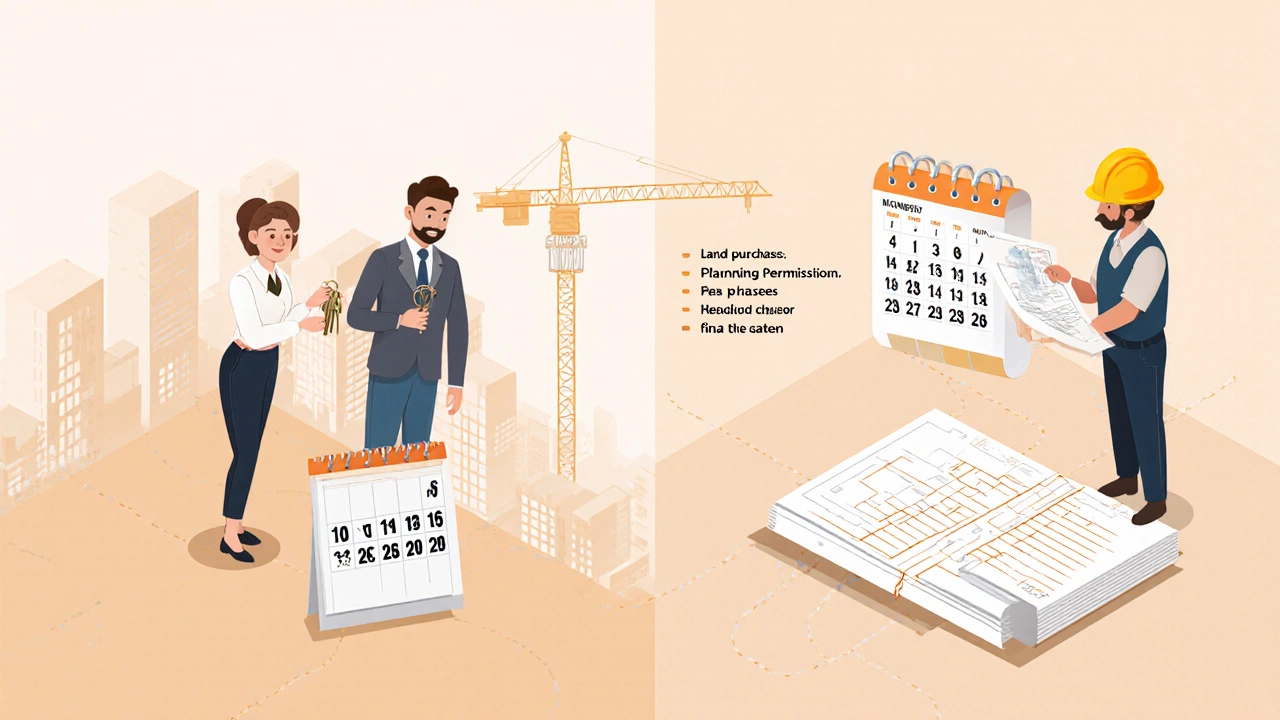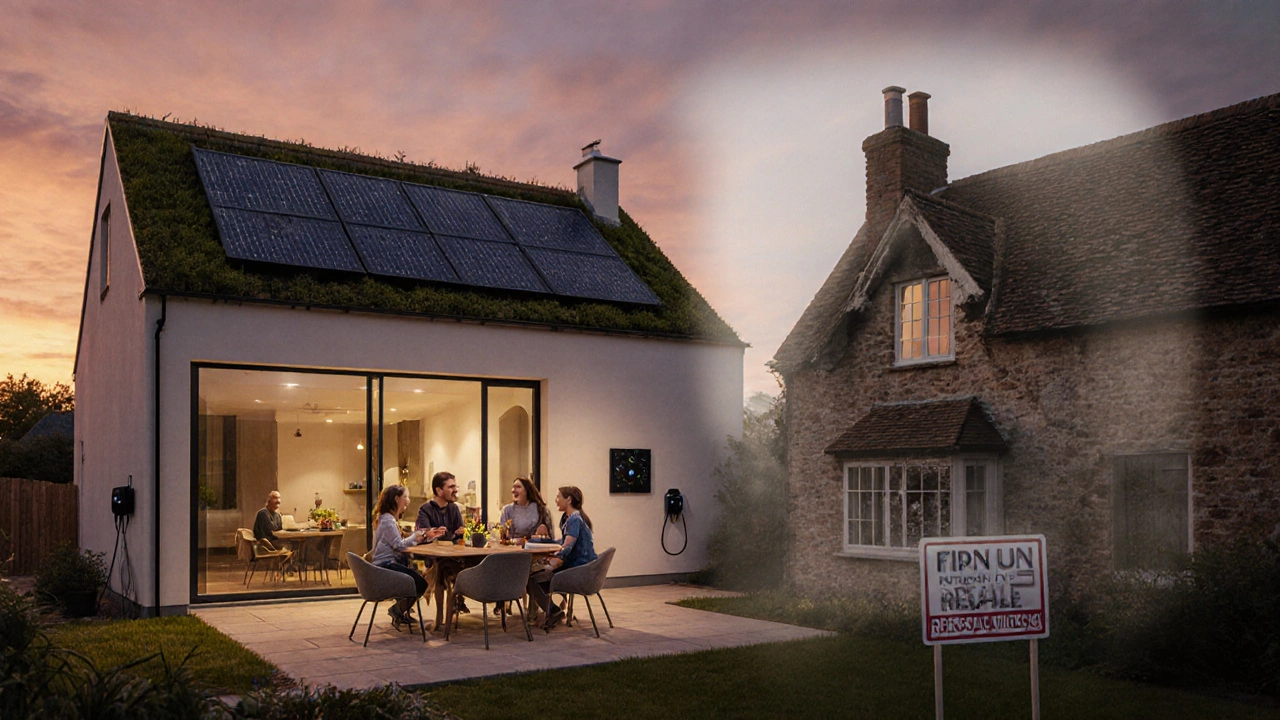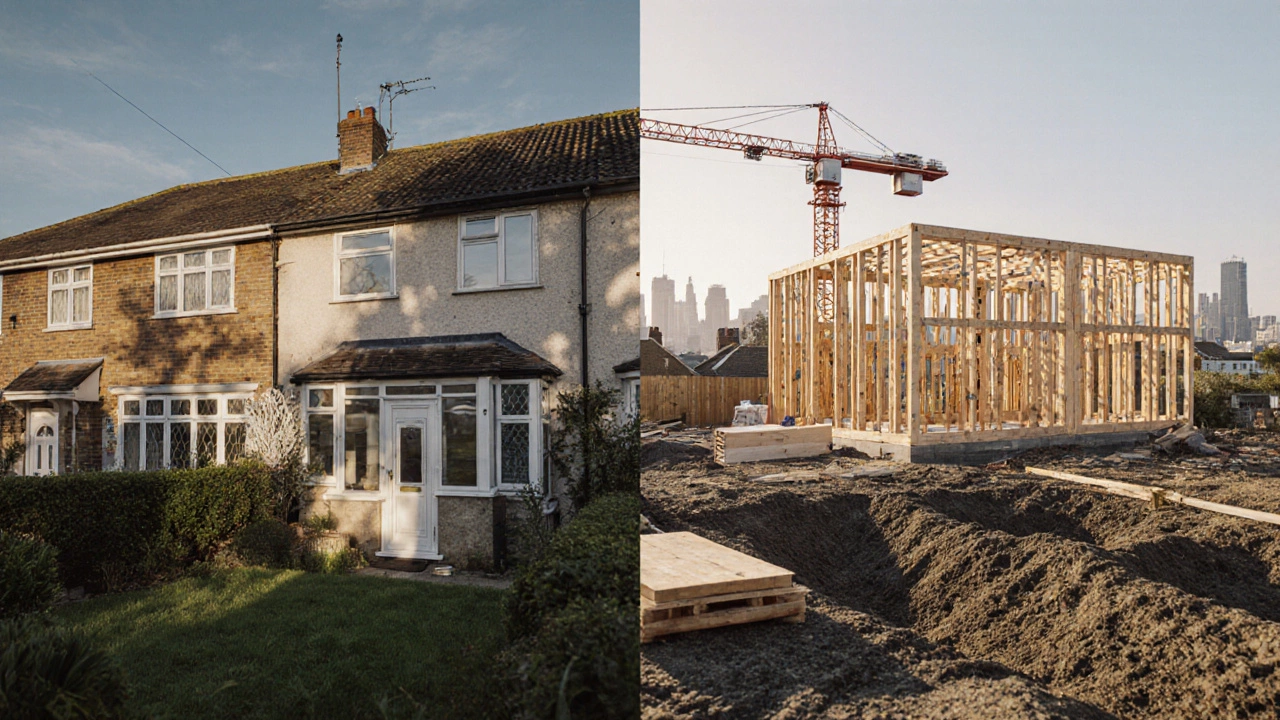Buy vs Build Calculator
Your Situation Assessment
Answer the following questions to calculate your score and determine whether buying or building is more suitable for you.
Your Recommendation
Based on your inputs, here's what we recommend:
Facing the decision of whether to buy a house means purchasing an existing property on the open market, usually with a ready‑made layout and immediate occupancy or to build a house involves acquiring land, securing planning permission and overseeing construction from foundation to finish can feel like a giant spreadsheet you never wanted to open. The short answer is that there is no one‑size‑fits‑all answer - it depends on your budget, timeline, desire for customization, and how much risk you’re comfortable taking. Below we break the major factors down, give you a side‑by‑side comparison, and hand you a checklist so you can decide which path feels smarter for your situation.
Cost breakdown: What you actually pay for
When people compare buying vs building, they often look at the headline price and stop there. The truth is that every line item matters.
- Purchase price vs land price: An existing home in London’s outer boroughs averages £520,000 (2025 data). In contrast, a suitable plot of land in the same area runs about £180,000.
- Construction cost: The average new‑build cost per square metre in the UK sits at £2,250. A 150m² family home therefore costs roughly £337,500 before finishes.
- Finishing touches: High‑end kitchens, hardwood floors, and smart‑home wiring add another £50,000‑£80,000 for most families.
- Professional fees: Buying brings estate‑agent fees (often 1‑2% of the price) and solicitor costs (~£1,500). Building adds architect fees (≈8% of construction cost), structural engineer fees, and planning‑application fees (£462 for a full plan).
- Financing costs: Mortgages on existing homes average 4.1% APR in 2025, while construction loans often start at 4.7% and include interest reserves.
- Contingency budget: Builders suggest a 10% contingency for unexpected site conditions. Buyers rarely need this unless they plan major renovations.
Putting the numbers together, a typical buy might land you at £530,000 total, while a build could end up around £620,000 when you factor in land, construction, finishes, and professional fees. The gap narrows quickly if you opt for a modest design, use a cost‑effective builder, or purchase a plot in a less‑expensive region.
| Item | Buy a House | Build a House |
|---|---|---|
| Property/land acquisition | £520,000 | £180,000 |
| Construction cost (150m²) | - | £337,500 |
| Finishes & upgrades | Variable (often included) | £65,000 |
| Professional fees | £5,000-£10,000 | £30,000-£45,000 |
| Financing interest (first year) | £21,500 | £27,500 |
| Contingency (10%) | - | £38,750 |
| Total estimated outlay | ≈£530,000 | ≈£620,000 |
Timeline: How long each route takes
Time is money, especially when you need a roof over your head by a certain date.
- Buying: In a hot market, you might complete the transaction in 6-8 weeks after an offer is accepted. If you’re waiting for a mortgage approval, add another 2-3 weeks.
- Building: From land purchase to moving in, the average timeline is 12-18 months. Securing planning permission can take 2-4 months; construction itself usually occupies 9-12 months, and the final snagging period adds another 1-2 months.
If you need a home now, buying is the obvious shortcut. If you can be patient and want a tailor‑made layout, the longer build timeline becomes a worthwhile trade‑off.

Customization: How much of your dream can you actually shape
When you build a house you control floor‑plan, materials, energy‑efficiency standards, and even the orientation of windows for passive solar gain, you get to embed every wish list item. Buying a house rarely offers that level of freedom; you can remodel later, but structural changes cost thousands and often require planning permission.
- Layout flexibility: Building lets you decide on open‑plan versus traditional room divisions, wheelchair‑friendly staircases, or a home office with a separate entrance.
- Energy performance: A new build can achieve Pass‑IV standards (U‑value ≤0.15W/m²K) straight away, while retrofitting an older home to the same level can be tricky and pricey.
- Future‑proofing: Wiring for electric vehicle chargers, pre‑installed fiber optic cables, and raised floor joists for underfloor heating are easier to incorporate at the build stage.
If you value a home that matches your lifestyle down to the tiniest detail, building clearly wins. If you’re happy with a solid baseline and plan modest upgrades, buying may be sufficient.
Financing: Mortgages versus construction loans
Both paths need borrowing, but the products differ.
- Mortgage is a long‑term loan secured against an existing property, typically released in a single lump sum. Lenders like to see the property as collateral, so they often offer lower rates and longer terms (up to 35years).
- Construction loan is a short‑term, interest‑only facility released in stages as the build progresses, converting to a standard mortgage once completion is certified. Rates are higher and lenders may require a larger deposit (often 30%).
One practical tip: If you already have equity in an existing property, you can use a bridging loan to fund the land purchase and early works, then switch to a build‑to‑completion loan. This reduces the overall interest paid compared to juggling two separate mortgages.
Risk factors and hidden costs
Every project has surprises. Knowing the typical pitfalls helps you budget realistically.
- Planning permission delays: Unforeseen objections from neighbours or council can add 2-3 months and £5,000‑£10,000 in legal fees.
- Site conditions: Unstable ground may require deep foundations, which can increase the construction budget by 15% or more.
- Supply chain volatility: Post‑Brexit material shortages have pushed timber prices up 20% in 2024‑25, inflating build costs unexpectedly.
- Market swings: If house prices fall during a long build, you could end up with a property worth less than you spent. Buying locks in the market price at the time of sale.
- Project management: Without a competent builder or project manager, delays and cost overruns are common. Hiring a reputable builder adds 5%‑7% to the contract but often saves money in the long run.
People who underestimate these risks usually end up stretching their finances or settling for a compromised design. A solid contingency plan is essential for either route.

Long‑term value: Resale potential and maintenance
When you step back and look ten years ahead, two things matter most: how much the property appreciates and how much you’ll spend keeping it in shape.
- Resale premium for new builds: In most UK regions, a home less than five years old commands a 5%‑8% price premium over comparable older homes, mainly because buyers value modern standards and lower immediate maintenance.
- Maintenance costs: An older property often needs roof repairs, boiler replacements, or damp treatment. Over a decade, these can total £30,000‑£50,000. A new build typically requires only routine servicing during the same period.
- Energy savings: New‑build homes consume roughly 30% less heating energy, saving £900‑£1,200 per year on utility bills. Over 15 years, that’s a £13,500‑£18,000 advantage.
So while the initial outlay for building may be higher, the lower running costs and resale premium can make it the smarter financial choice for many.
Decision checklist: Which path fits you?
- Do you need a home now? If you must move within six months, buying is the only realistic route.
- What’s your budget ceiling? Include land, construction, finishes, professional fees, and a 10% contingency. If the total exceeds your maximum borrowing capacity, buying is safer.
- How much customization matters? List the non‑negotiables (e.g., home office, eco‑standard, number of bedrooms). If you have more than three essential custom features, building gives you control.
- Are you comfortable with project risk? If you prefer a fixed price and predictable timeline, a reputable builder with a guaranteed‑price contract reduces uncertainty.
- What’s your long‑term plan? If you intend to stay 10+ years, the lower maintenance and energy savings of a new build may outweigh the higher upfront spend.
Score each item (1=low importance, 5=high importance). Add up the points. A total above 18 usually signals that building aligns with your priorities; below 12 points toward buying; anything in‑between suggests a hybrid approach-buying a fixer‑upper and renovating it yourself.
Frequently Asked Questions
Is it cheaper to buy an existing house than to build a new one?
Generally, buying an existing home has a lower upfront cost because you avoid land purchase and construction expenses. However, you must factor in renovation costs, higher maintenance, and potentially less energy efficiency. For many families, the total 10‑year cost of a modest new build can be comparable or even lower once energy savings and maintenance are accounted for.
How long does it take to get planning permission for a new house?
In England, a full planning application typically takes 8‑12 weeks for the council to decide, but complex sites or objections can stretch the process to 6 months. Early engagement with a planning consultant can shave a few weeks off the timeline.
Can I finance the land purchase separately from the construction loan?
Yes. Many buyers use a short‑term bridging loan or a personal loan to secure the plot, then refinance into a dedicated construction loan once the build begins. This approach can reduce interest costs because you only pay high‑rate interest on the land portion for a short period.
What are the biggest hidden costs when building a house?
Unexpected site conditions (like contaminated soil), design changes mid‑project, and price spikes for materials such as timber or steel are common hidden expenses. Adding a 10% contingency to your budget is the most reliable way to cover these surprises.
Will a new build have a higher resale value than an older property?
In most UK markets, a home less than five years old sells for 5%‑8% more than a similar older house, largely because buyers value modern energy standards, lower maintenance, and contemporary design. The premium can widen if the new build meets high sustainability certifications (e.g., Pass‑IV).
